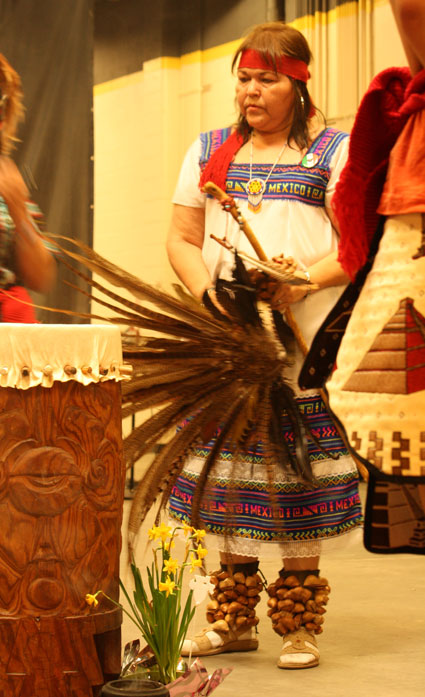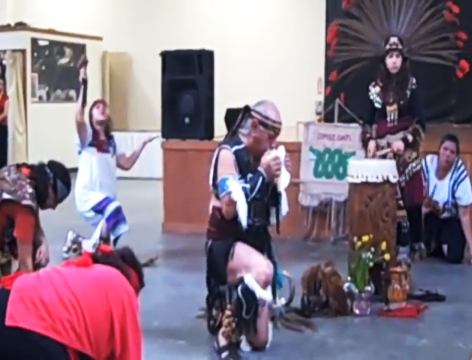EL PASO — Two elders lifted conch shells to their lips and bellows from these primal trumpets — primordial prayers aimed at the sky — signaled to a third man to kneel as smoky incense wafted from a clay cup in his left hand.
The offering ceremony, repeated three times as the heuy tecuhtlis, or elder leaders, paid tribute to mother earth in a rite that has been performed for thousands of years, long before European settlers set foot in the new world.
This is how the Danza Azteca, or Aztec Dance, began at the Mercado Mayapan, a local marketplace and community center.
“The dances that we do are thousands of years old. They’ve been passed down from generation to generation,” said Ramón Arroyos, 60. “It’s important because it’s maintaining our tradition, maintaining our culture, maintaining our identity.”
Arroyos is one of the founders of Danza Azteca Chichimeca Omeocatl, an El Paso group that aims to revive and pay tribute to the customs of their Mexican ancestors.

Dancers gather and prepare before presentation (Raymundo Aguirre/Borderzine.com)
Omeocatl was founded 10 years ago, and its members range in age from 19 to 63 years. Seven men and women wearing embroidered clothing and bright sashes danced in a circle around a drum, a clay container of water, incense, flowers and reed instruments — all offerings to mother earth.
The solemnity of the deep drumming was in contrast to the young female face of the drummer or Huehuetzonani, and the rhythmic rattle of the ayoyotes, or seed leggings, strapped around the dancers’ feet.
“We’re trying to become the embodiment of Quetzalcoatl, who taught to love and create beauty,” said Gisela Fuller, capitana of the group. The feathered headpieces and the rattling leggings tied by a sash represent the physical manifestation of the feathered serpent god venerated by the Aztecs, Fuller said.
The group was invited to perform by La Mujer Obrera, a nonprofit organization that through exhibits, performances and round table discussions, is celebrating the legacy of the Chicano movement in El Paso during February.
Culture and the preservation of tradition, as well as the political advancement of Mexican-Americans and Mexican immigrants in the U.S. were important factors for the Chicano movement of the 1960s and 1970s, said Irma Montoya, executive director of La Mujer Obrera.
“They were also fighting for art and culture. So it is because of that that we, as La Mujer Obrera and Mercado Mayapán, are trying to promote and rescue the legacy of the Mexican culture,” Montoya said.
The Chicano movement helped resurrect an interest in many traditions that Mexican-Americans were moving away from as a result of assimilation into mainstream American culture.
The depreciation of Mexican traditions at the beginning of the 20th century resonated heavily with the enslavement of the[A1] mechica, as some Aztecs called themselves, by Spanish conquistadors. The word Chicano, though its origins are unclear, has been attributed to be a derivation of mechica.
“I think everybody that sees themselves as Hispanic because they have Spanish blood needs to realize that their true identity is American Indian,” Arroyos said. “It’s really a genocide that they [the Spaniards] tried to commit on us. They tried to erase us from the face of the earth and give us another identity.”
According to Arroyos, the mechica dance movement was revived in the early 1970s in the U.S., after it was brought over by generations as early as the 1940s. Fuller added that, among other reasons, it can be performed as an expression of celebration, mourning and gratitude.
“Today we’re here for the Chicano movement, so we’re going to pray about that. We’re going to give thanks for what these people did for us so many years ago and hope that it continues on because that struggle still exists,” Fuller said.

Aztec dance by Danza Azteca Chichimeca Omeocatl at Mercado Mayapán (Pamela Prieto/Borderzine.com)
La Mujer Obrera’s own financial struggles almost drove the center to a permanent shutdown last summer, but Montoya reported that despite the harsh economy, they are moving forward.
“Right now, we are doing all right,” she said. “We continue to train our partners in the community, especially women, which are the most unprotected by society. We are empowering them through education, training and by providing a worthy job.”
Part of that empowerment comes through reviving traditions and through performances like the one by the Omeocatl dancers.
“We really see it as a prayer, not as a performance,” Arroyos said. “We begin with a prayer to the four directions; we ask permission from the east, west, then south and then north… But it’s a prayer and our prayer and our dances are always for mother earth, nuestra madre la tierra, Tonantzin Tlalli in the Aztec language.”

¡Qué viva el movimiento chicano!